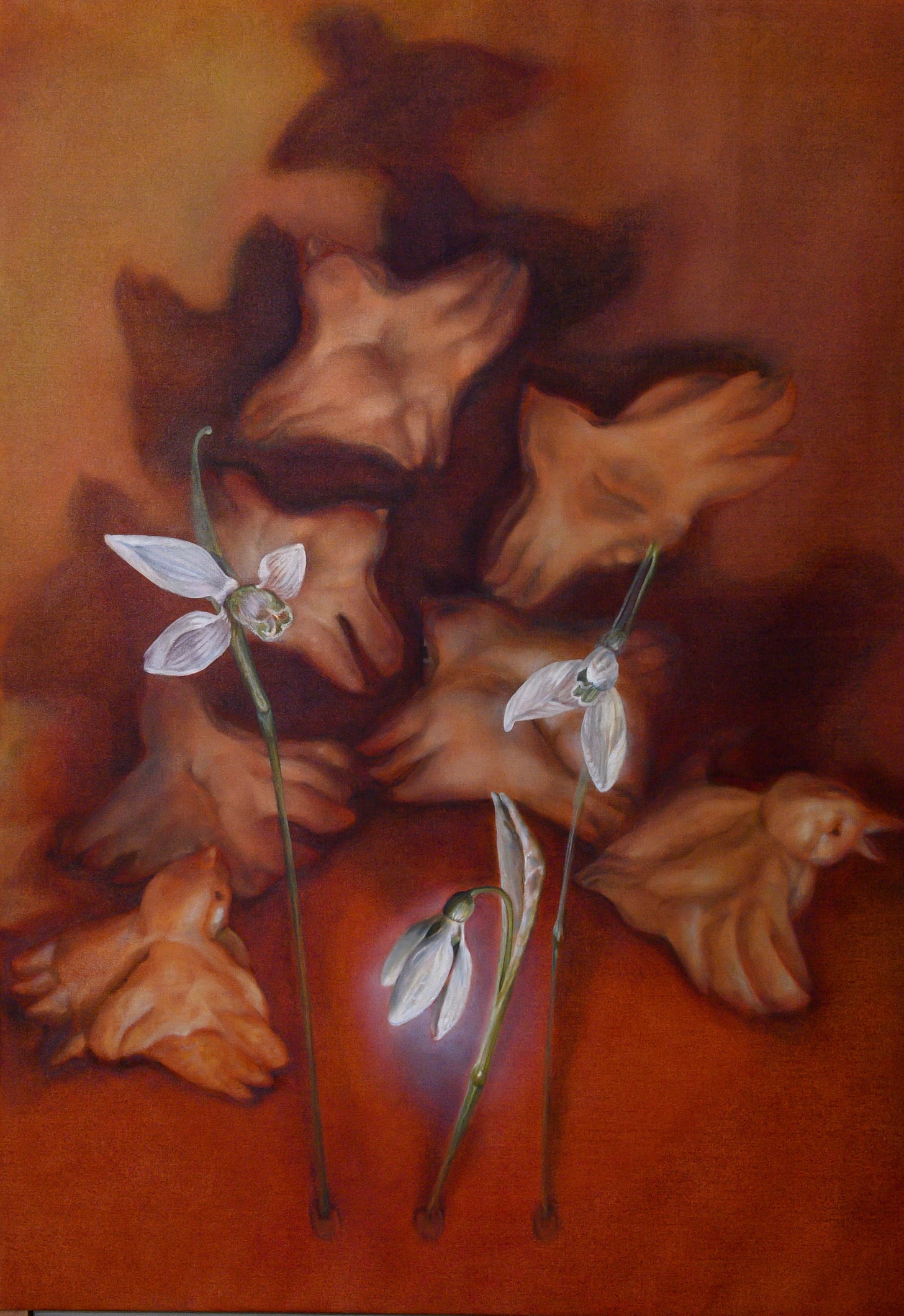I have known the multidisciplinary artist Olha Pryymak for over four years now. Over time, I have seen her artistic practice shape, evolve and expand through folkloric storytelling and an exploration of grief brought forth by current events in her home country of Ukraine. I first came across Olha's paintings when she was studying for her MA at the Royal College of Art and have seen her incorporate social practice, especially household herbalism, over time either through tea ceremonies, ritualistic object workshops or gatherings. I recently visited her studio in East London, where she invited me to see her studio setup, her process, and the varied scale of her paintings.
Leading up to the UCL Trellis Public Programme that just passed and her recent group show at Studio West Gallery titled "Making Kin", we had an informal conversation about her works, her inspirations and her models in her studio with collected herbs, wheat, cones and other plants where she blows them up into human size paintings in scale. For Olha, plants are both a medium and a protagonist: a vehicle for storytelling and the matter from which the works are derived.
Through paintings and performances, Olha investigates the symbolic resonances, medicinal uses, and cultural histories of specific flora and fauna. Within this, a sustained area of exploration is the various relationships humans have cultivated with plants throughout history and in many different locations, inspired by the writings of scholars such as Donna Haraway and Robin Wall Kimmerer.
Enjoy the free-flowing, insightful conversation, which is a step into the artist's world…
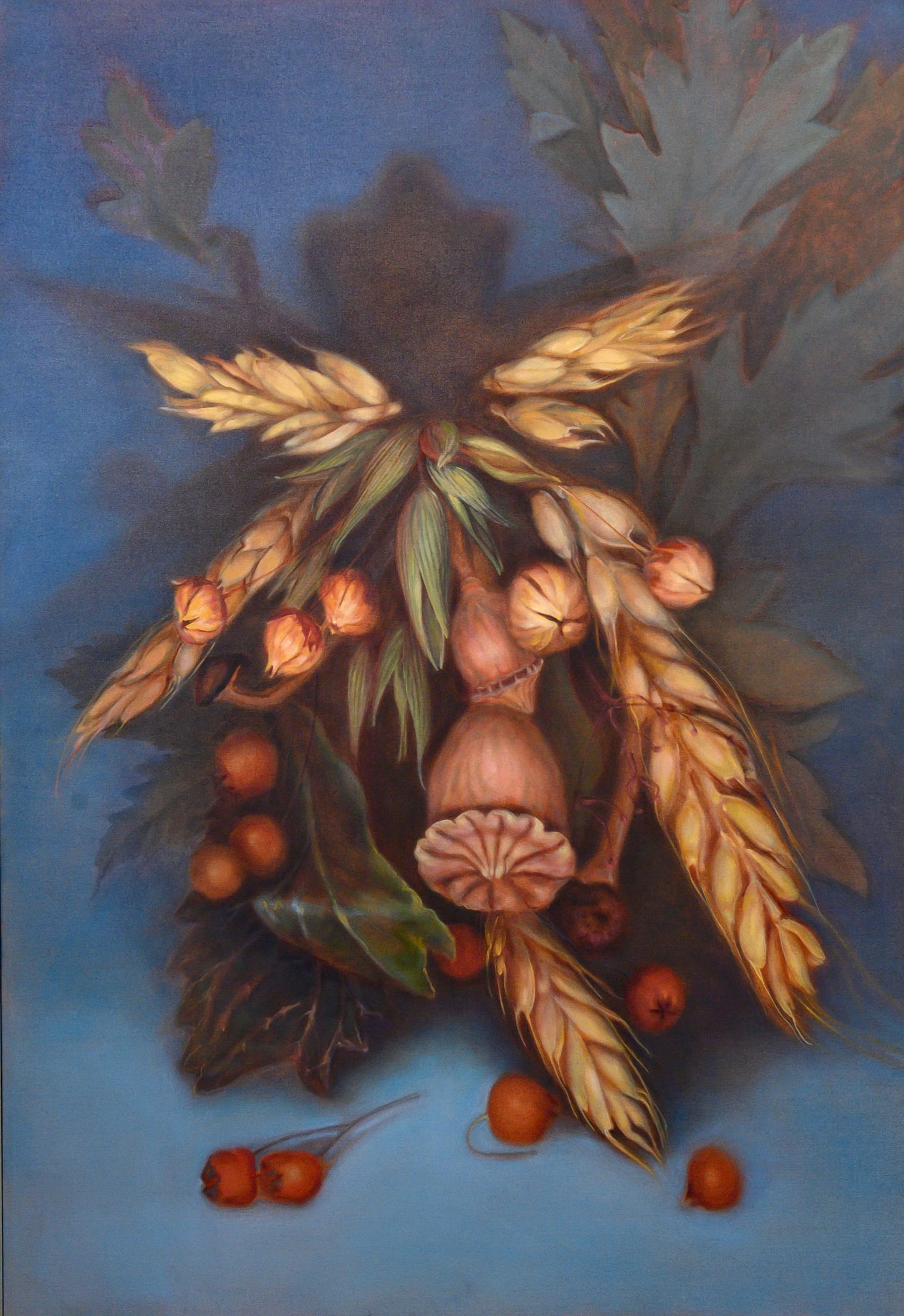
HK (interviewer): Hi, Olha; thank you for inviting me to your studio to conduct this informal interview exploring plants as healing properties and rituals in the context of your artistic practice. Let's start talking about your creative practice, how your interest shapes your painting and practice over time, and how you get inspired. You just showed me something you collected that derived from your newest painting, which you're exploring now. For those who don't know much about your works, it would be great to discuss your painting practice and how that links to your personal history.
Olha (interviewee): There's a lot of history. I heard this quote the other day in a talk I attended. I think it was something like, "Definition of history is a study of change." I was moved by it.
HK: Wow, so true.
OP: Isn't it… the study of change? There's just so much in it because this is precisely the reason why I probably started looking at plants. When we first met, I was doing just the tea sessions. We were only... I was looking at them from a herbal, medicinal, magical perspective.
HK: …And as healing properties.
OP: Healing, first of all. Not just because I was homesick but because I was starting to think about my roots when I was here in London. Shortly after the invasion of the East and the annexation of Crimea happened, it was vital for me to rethink everything. It was shocking. And then that's the first thing you think about, which is why, so you look at history, and I was looking at my family, which is very local, very specific. How did they get through all these previous waves of history?
HK: I guess it dates back to your lineage before the recent war.
OP: Yeah. And it was very self-reliant. It was about using the materials around you; herbs were the most important medicine. But most recently... When I first met Sophie, the researcher from UCL who specialises in medieval history and magic, that interest fuelled even more information, and she encouraged me to look at this as practice from the historical and academic point of view.
HK: So, the study of magic contextualised the personal history and practice?
OP: Through that study of magic, I realised that it wasn't just the practical "drink this, and you'll feel better"; there's the spiritual side of using the plants that happened.
HK: Like the ritualistic aspect?
OP: Yes.
HK: It is interesting how each culture has a ritual. For example, in Turkey, burning sage to clean space is so normalised that it is not considered "witchy," or pouring water after someone leaves, so they have swift travel is done quite often. There must be some similarities.
OP: Absolutely. That's why it got so exciting, and we developed this project based on Ukrainian ritual folk. But it's so universal that it managed to reach out to participants, to local participants from any culture. Bringing out their people's mythologies and associations with materials felt inclusive and encouraging. Natural materials like plants are tactile, so they activate the senses of touch and smell too. When you handle this, you start thinking with the whole body, especially if it's in an art context of make-believe imagination. And that's what art can do. And set this stage for speculation and bring out your mythologies. So workshopping the ritual objects and making them like the little; for instance, this is technically a sheaf of wheat; it's called Didukh, an ancestor's spirit. This is where I got an idea of painting shadows. That painting is a representation of the character of Didukh.
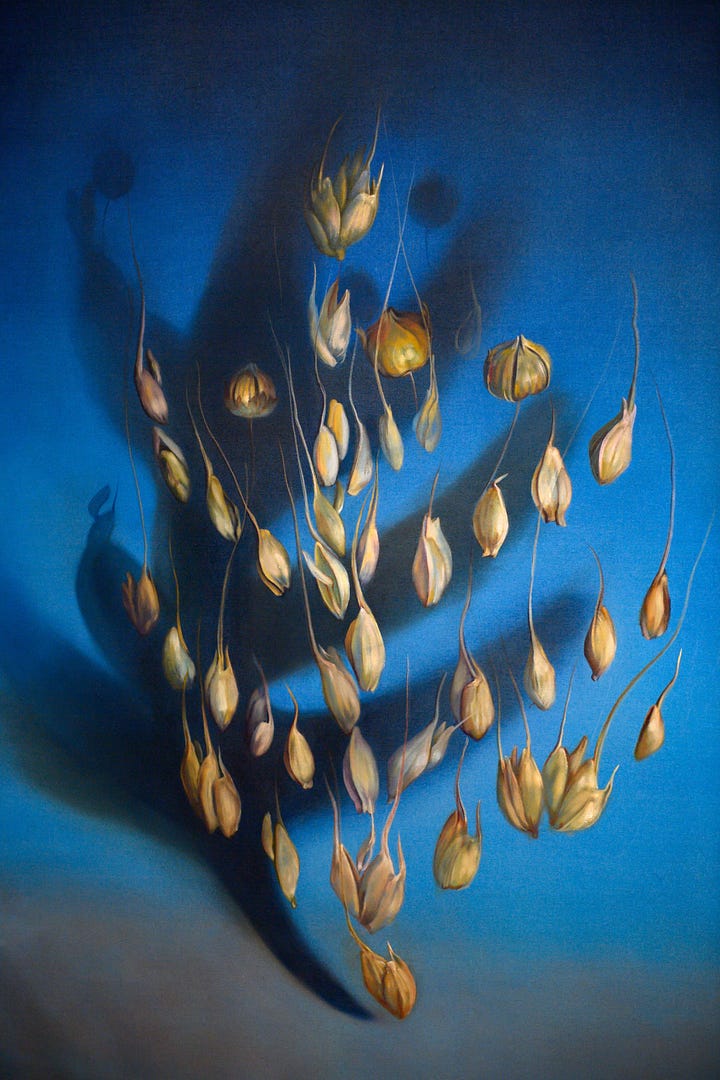
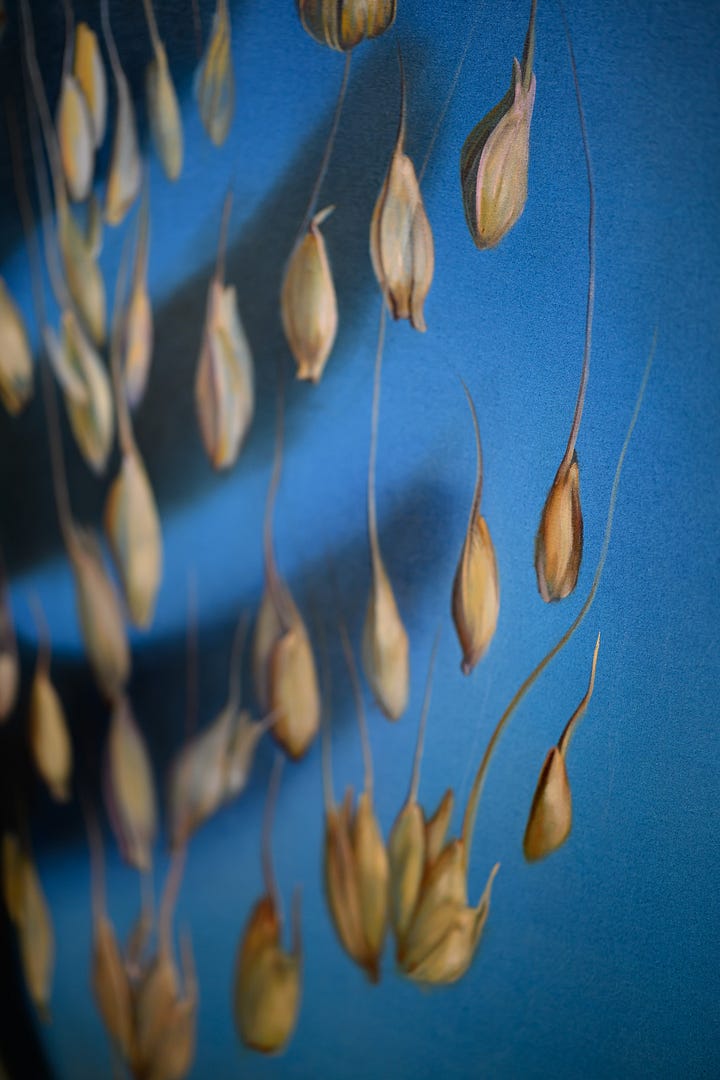
Olha shows me her box models with plants inside as inspiration for her paintings.
HK: It's beautiful.
OP: This thing is pre-revolution, which was used instead of Christmas trees. People would take the last sheaf of wheat off their field, and now they'll save it for around winter solstice. And then, they would decorate it and put it on the table. And that would be like a wish for the future. Where's my other one? Oh, it's just that one.
HK: So, do you forage these plants and other things?
OP: Right. So... A lot of them.
HK: Oh, wow. I also love the large scale of your paintings and how you play with shadows compared to miniature paintings, which are more intimate.
OP: That is all about the play of shadows because you would think it's why there used to be so many spirits back in the day. People believed in it, but there are not so many now. Is it because we just got lazy? Or did the science thinking kill them off because?
HK: Also, technology.
OP: Technology. But now it's coming back, but in a very different way. It comes back, at least, how to say, the productive side of that imagination. It has a lot of nourishing potential that painting can host.
HK: That's the part that I want to talk to you about, which I still need to follow up on in the workshop. So, these little plants are tiny and perishable. Over time, they shrink too.
OP: Yeah, they return to the soil, and the new plants grow. So they're part of this cycle. There's an excellent way to do it. But what we do with them is very important because whenever you create a situation like in a workshop for people to handle the plant, to make something like this or like a little grass doll, it activates this touch-feel knowledge, something beyond intellectual. And then many exciting references start coming up, and it brings up.
In the same way, painting can contain all these different references to different cultures from other territories, different timeframes, mythologies, and even science. You can talk about the science side of what we know, and these conversations can be contained within a painting that represents that and encourages further discussion. So that's the materiality that is so easy for me to produce these paintings informed by these exchanges.
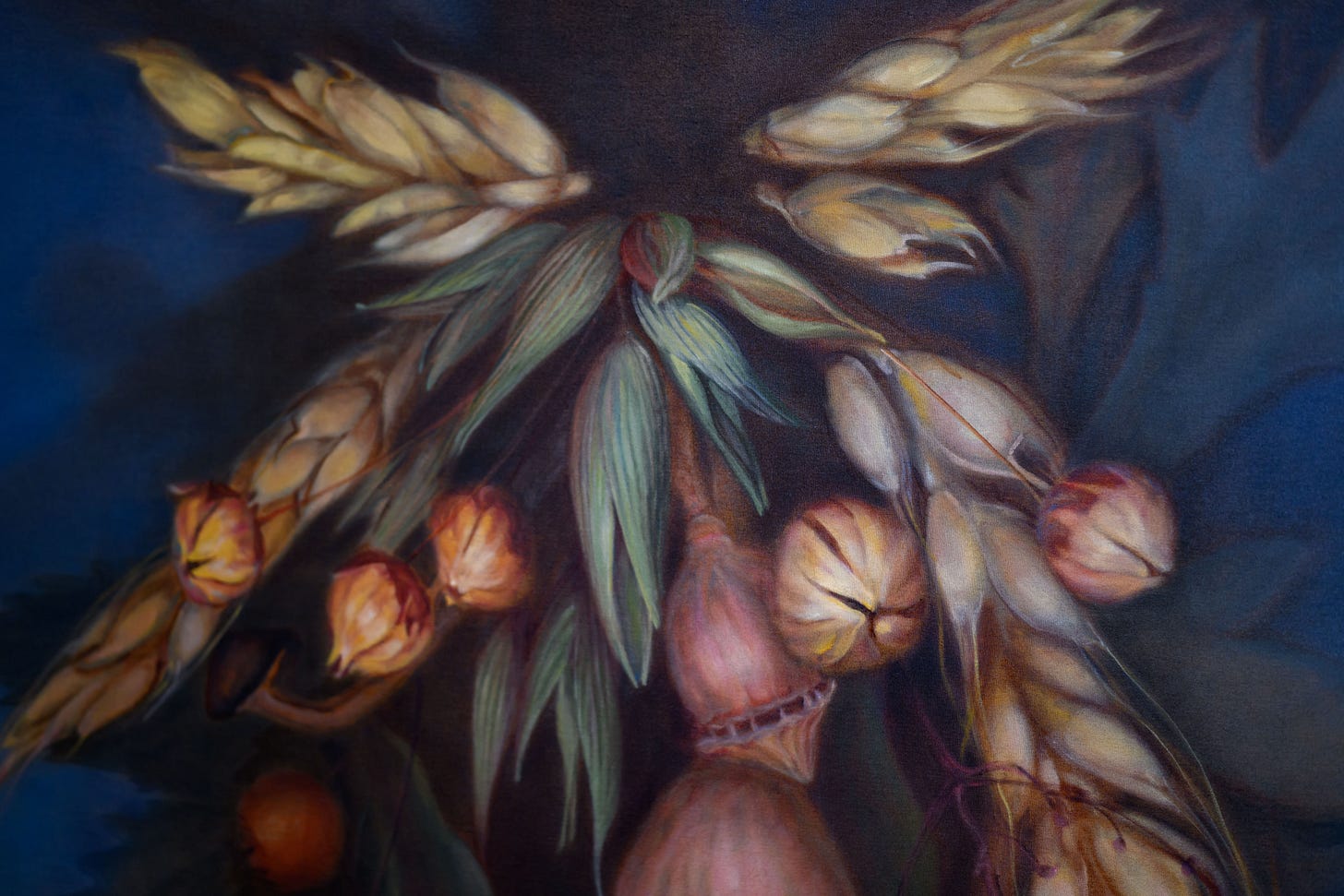
HK: Let's talk about the workshop you hosted at OSHS projects as a part of the "Bread" exhibition with corn dollies representing the perishable material culture of the rural people living in Ukraine. How did the audience react to the event?
OP: It's exciting that we attracted many people of different ages to the workshop. There were many young people, and knowing that many were looking for that association was very flattering. They're having a similar journey that I had to go through trying to evaluate their received knowledge and finding their own mythology. And most likely, most of them care about some memory of that through their roots. And not just in Ukrainian culture but everywhere across the country. But also, the older people who are the actual carriers, like my parents, I got them involved in making the candles because my dad's a beekeeper. So, he would demonstrate the dipping side of the candles. If you look at the video documentation, it's fascinating. He's explaining it by doing things. His English could be more robust, but there's virtually no need for verbal conversation.
HK: Since we are in your studio, I'd love to ask you about the materials you use for your canvas. Is that linen? Do you paint traditionally, and what is your process?
OP: I'm using linen for all of these works. We happened to have grown the linen. Cordwainers have grown a patch of linen at their garden where they hosted our outdoor workshops and then demonstrated how to make string that goes into making canvas. The process is very laborious, and they demonstrated how to make a thread from the actual plant there. Everyone just ended with this little thread. Imagine making the whole this. Anyway, I buy linen from my local shop; it's Belgium, so it's locally grown. It's expensive.
HK: I lreally ike the texture. It is very strong.
OP: There's five times less water required to grow a field of the same linen than it's like a field of cotton.
HK: Wow. So it's more ecological and sounds more sustainable. So yeah, you are conscious about this. Also, in terms of the paint, I love the texture and the colour—even with the more miniature paintings.
OP: I use quite a traditional way of painting it—Velazquez technique. So yes, its oil paint started with underpainting. In terms of sustainability, yes, it'd be better not to produce anything at all, but...
HK: You have to produce, right? You're an artist.
OP: It's not because of continuous occupations, comparatively little monumental cultural artifacts were preserved. My people were primarily practising this culture, making perishable natural materials, which disintegrate after being made and put on earth. That's one of the continuous colonialism of the territory.
HK: I was going to say the colonialism and the layers and layers of...
OP: It's one of the most fertile lands. It's always been there. And the people knew how to work it to produce the surplus of wheat, besides the Soviets and the Russian Empire, before that there were the Poles, Lithunians, etc. I mean, Hitler had this idea of Lebensraum to exterminate the locals and put his own things. In Herodotus times, Greeks were buying wheat from the people who used to live in that territory. So it's always been the breadbasket and it's always been the materials, probably. With the social making workshops and in these monumental-sized paintings I invite people to imagine what the culture can be like.
HK: Thank you for showing me around and shedding light to your practice and personal history for the Curious Curator Substack subcribers! I really enjoyed the studio visit.
OP: Thank you for coming!




